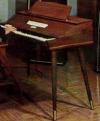photos courtesy of The Audities Foundation.
The explorer was the first model to be manufactured under the RMI name. The original prototypes were produced in a low profile wood case with a walnut finish. These prototypes units were produced under the Allen name. The production run was housed in a plywood case, designed in the style that would become typical of most RMI products, for years to come. The case was finished with a speckled paint, the bottom in green and the upper in blue and had chrome-folding legs. Although the brochure states the instrument was produced with a vinyl material, I do not remember it being ever manufactured that way, nor I cannot verify that it was.

The tone generation system consisted of circuitry patented by the Allen Organ Company. It used an individualized transistor oscillator circuit for each of its forty-nine note keys. This was the basic design for most of the analog RMI keyboard products produced in the future.  The most unique feature of this instrument is the patented Flying Hammers. This consisted of a piece of spring steel with a lead weight attached. There was one of these assemblies per note. When a key was depressed, the hammer would vibrate against a contact, turning the oscillator on and off. Depending on how hard the note was hit, the decay characteristics for each note were different. This feature produced an excellent mandolin and banjo effect.
The most unique feature of this instrument is the patented Flying Hammers. This consisted of a piece of spring steel with a lead weight attached. There was one of these assemblies per note. When a key was depressed, the hammer would vibrate against a contact, turning the oscillator on and off. Depending on how hard the note was hit, the decay characteristics for each note were different. This feature produced an excellent mandolin and banjo effect.
The prototypes were manufactured in 1966, and the production units were produced in 1967 and 1968. The retail cost of the instrument was $845.

